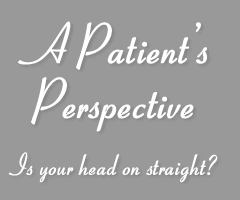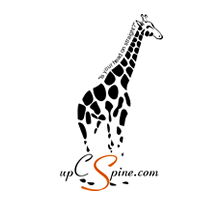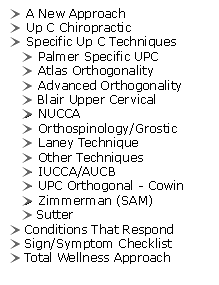Home | A New Approach | Specific Up C Techniques | Atlas Orthogonality
ATLAS ORTHOGONAL - DR. ROY SWEAT

 The
first UpC approach, which I will summarise, is that which was pioneered
and developed by Dr. Roy Sweat pictured here with his adjusting
instrument, the Sweat Percussion Instrument, which imparts a percussion
(sound wave) to make the atlas adjustment. This UpC approach is
one of the first UpC approaches I came across in my research and
is known as Atlas Orthogonal (AO). Like many orthogonal UpC techniques
it has its roots in the Grostic measurement system and the adjustment
technique is an evolution of B.J. Palmer’s Hole in One toggle
recoil adjusting technique. I have personally found it to be an
amazing experience and having witnessed first hand many people,
children and adults alike, improve dramatically within minutes to
hours of an adjustment, I have no doubt that this UpC chiropractic
approach will continue to provide many suffering people wonderful
relief from chronic illnesses. This is probably the easiest adjustment
technique to explain to people. When explaining it I always use
the example of ultrasound. Most people know what ultrasound is and
would have no qualms about submitting themselves to an ultrasound
examination. They feel nothing when the ultrasound wave is turned
on and used to examine their anatomy. Likewise, patients of the
AO chiropractor will feel mostly nothing when the Sweat percussion
instrument is activated, and their atlas is adjusted. This is so
gentle that in many cases patients can doubt any adjustment is performed,
and might ask the AO doctor, “Did you do anything?”
or “Is that it?” The atlas adjustment is so gentle that
you would actually feel more if someone was to ‘blow
in your ear’. The only things that some people do
feel is a strange warm feeling or an overwhelming feeling of well
being, or in really dramatic cases, complete relief of symptoms
within minutes of the adjustment. My view is that the warm feeling
is either an arterial release at the atlas level or immediate positive
adjustments made by one’s nervous system. The
first UpC approach, which I will summarise, is that which was pioneered
and developed by Dr. Roy Sweat pictured here with his adjusting
instrument, the Sweat Percussion Instrument, which imparts a percussion
(sound wave) to make the atlas adjustment. This UpC approach is
one of the first UpC approaches I came across in my research and
is known as Atlas Orthogonal (AO). Like many orthogonal UpC techniques
it has its roots in the Grostic measurement system and the adjustment
technique is an evolution of B.J. Palmer’s Hole in One toggle
recoil adjusting technique. I have personally found it to be an
amazing experience and having witnessed first hand many people,
children and adults alike, improve dramatically within minutes to
hours of an adjustment, I have no doubt that this UpC chiropractic
approach will continue to provide many suffering people wonderful
relief from chronic illnesses. This is probably the easiest adjustment
technique to explain to people. When explaining it I always use
the example of ultrasound. Most people know what ultrasound is and
would have no qualms about submitting themselves to an ultrasound
examination. They feel nothing when the ultrasound wave is turned
on and used to examine their anatomy. Likewise, patients of the
AO chiropractor will feel mostly nothing when the Sweat percussion
instrument is activated, and their atlas is adjusted. This is so
gentle that in many cases patients can doubt any adjustment is performed,
and might ask the AO doctor, “Did you do anything?”
or “Is that it?” The atlas adjustment is so gentle that
you would actually feel more if someone was to ‘blow
in your ear’. The only things that some people do
feel is a strange warm feeling or an overwhelming feeling of well
being, or in really dramatic cases, complete relief of symptoms
within minutes of the adjustment. My view is that the warm feeling
is either an arterial release at the atlas level or immediate positive
adjustments made by one’s nervous system.
The Sweat AO system involves the
use of a 3 main X-rays that are usually taken with the patient’s
head clamped in order to ensure accurate comparisons of atlas position
before and after the adjustment. You will note the 3 X-ray views
following. The one on the far left is the sagittal or side view,
and is mostly used to acquire a lateral angle of the atlas (plane
line) and to observe cervical lordosis (neck curve), the middle
one is the nasium view which gives an immediate view of the alignment
between the head and the neck and the position of the atlas relative
to ground, and the third is the vertex view which is taken through
the top of the skull and shows again the position of the atlas relative
to the skull. All three views are used to calculate the angle of
attack for the adjusting instrument.
From the X-rays taken and tables
developed by Dr. Sweat et al, the UpC AO Doctor can accurately
position
the percussion instrument on the transverse process of the patient’s
atlas just behind their ear. Depending upon which way that patient’s
atlas has subluxated will determine the angle of delivery, appropriate
side (right or left), and the relative position to place the instrument’s
stylus; that is, anterior (forward), posterior (rear), superior
(above) or inferior (below) to the atlas transverse process. Once
the stylus is positioned the percussion wave is activated and
the
percussion wave leaves the stylus at about 4 to 6 pounds force
and travels to the atlas where it is only a force of a few
ounces.
The atlas is moved and the occipital condyles of the skull reposition
into the condylar articulation surfaces on the atlas. The natural
human healing process then begins.
AO MOVIE
 To
show the effectiveness of the adjustment to the atlas, Dr. Sweat
had a video fluoroscopy X-ray (VF) developed. This movie (QuickTime)
of the VF following is a short 50 second extraction from a longer
video “Atlas Orthogonal Introduction With Fluoroscopy”
by Dr. Sweat and Dr. Gary Boring. This longer video explains the
AO approach and methodology in more detail. You can order a copy
from the Sweat Foundation, 3274 Buckeye Road, NE, Atlanta GA 30341,
USA. To
show the effectiveness of the adjustment to the atlas, Dr. Sweat
had a video fluoroscopy X-ray (VF) developed. This movie (QuickTime)
of the VF following is a short 50 second extraction from a longer
video “Atlas Orthogonal Introduction With Fluoroscopy”
by Dr. Sweat and Dr. Gary Boring. This longer video explains the
AO approach and methodology in more detail. You can order a copy
from the Sweat Foundation, 3274 Buckeye Road, NE, Atlanta GA 30341,
USA.
To view this adjustment technique
and its affect of the atlas, play this movie “Atlas Orthogonal
VF Adjustment".  (Quicktime
is required to view this movie) Click
here to download Quicktime (Quicktime
is required to view this movie) Click
here to download Quicktime
Comment from a Medical Doctor
on Atlas Orthogonal Chiropractic
"I am saddened by the thousands,
and probably millions, of patients that have problems that could
be helped by Atlas Orthogonal Chiropractic care, but don’t
know that it exists. We want every single patient we have under
care to have his or her spine examined by an Atlas Orthogonal Chiropractor.
If the alignment is wrong, the nervous system is not going to work
well no matter how good their nutrition is they are not going to
be able to assimilate that nutrition sufficiently. The majority
of cancer cases we see have overt cervical spinal problems, even
the ones who don’t have a history of spinal trauma."
Dr. Nicholas Gonzales, MD, Immunologist, Cancer Specialist
Letter
of Recommendation re: Atlas Orthogonal– Dr Stanley Block,
MD
DOWNLOAD
PDF |
(requires
Adobe Acobat Reader) |
atlas orthogonal.pdf
(366kb) |
|
|
|




 The
first UpC approach, which I will summarise, is that which was pioneered
and developed by Dr. Roy Sweat pictured here with his adjusting
instrument, the Sweat Percussion Instrument, which imparts a percussion
(sound wave) to make the atlas adjustment. This UpC approach is
one of the first UpC approaches I came across in my research and
is known as Atlas Orthogonal (AO). Like many orthogonal UpC techniques
it has its roots in the Grostic measurement system and the adjustment
technique is an evolution of B.J. Palmer’s Hole in One toggle
recoil adjusting technique. I have personally found it to be an
amazing experience and having witnessed first hand many people,
children and adults alike, improve dramatically within minutes to
hours of an adjustment, I have no doubt that this UpC chiropractic
approach will continue to provide many suffering people wonderful
relief from chronic illnesses. This is probably the easiest adjustment
technique to explain to people. When explaining it I always use
the example of ultrasound. Most people know what ultrasound is and
would have no qualms about submitting themselves to an ultrasound
examination. They feel nothing when the ultrasound wave is turned
on and used to examine their anatomy. Likewise, patients of the
AO chiropractor will feel mostly nothing when the Sweat percussion
instrument is activated, and their atlas is adjusted. This is so
gentle that in many cases patients can doubt any adjustment is performed,
and might ask the AO doctor, “Did you do anything?”
or “Is that it?” The atlas adjustment is so gentle that
you would actually feel more if someone was to ‘blow
in your ear’. The only things that some people do
feel is a strange warm feeling or an overwhelming feeling of well
being, or in really dramatic cases, complete relief of symptoms
within minutes of the adjustment. My view is that the warm feeling
is either an arterial release at the atlas level or immediate positive
adjustments made by one’s nervous system.
The
first UpC approach, which I will summarise, is that which was pioneered
and developed by Dr. Roy Sweat pictured here with his adjusting
instrument, the Sweat Percussion Instrument, which imparts a percussion
(sound wave) to make the atlas adjustment. This UpC approach is
one of the first UpC approaches I came across in my research and
is known as Atlas Orthogonal (AO). Like many orthogonal UpC techniques
it has its roots in the Grostic measurement system and the adjustment
technique is an evolution of B.J. Palmer’s Hole in One toggle
recoil adjusting technique. I have personally found it to be an
amazing experience and having witnessed first hand many people,
children and adults alike, improve dramatically within minutes to
hours of an adjustment, I have no doubt that this UpC chiropractic
approach will continue to provide many suffering people wonderful
relief from chronic illnesses. This is probably the easiest adjustment
technique to explain to people. When explaining it I always use
the example of ultrasound. Most people know what ultrasound is and
would have no qualms about submitting themselves to an ultrasound
examination. They feel nothing when the ultrasound wave is turned
on and used to examine their anatomy. Likewise, patients of the
AO chiropractor will feel mostly nothing when the Sweat percussion
instrument is activated, and their atlas is adjusted. This is so
gentle that in many cases patients can doubt any adjustment is performed,
and might ask the AO doctor, “Did you do anything?”
or “Is that it?” The atlas adjustment is so gentle that
you would actually feel more if someone was to ‘blow
in your ear’. The only things that some people do
feel is a strange warm feeling or an overwhelming feeling of well
being, or in really dramatic cases, complete relief of symptoms
within minutes of the adjustment. My view is that the warm feeling
is either an arterial release at the atlas level or immediate positive
adjustments made by one’s nervous system. 


 To
show the effectiveness of the adjustment to the atlas, Dr. Sweat
had a video fluoroscopy X-ray (VF) developed. This movie (QuickTime)
of the VF following is a short 50 second extraction from a longer
video “Atlas Orthogonal Introduction With Fluoroscopy”
by Dr. Sweat and Dr. Gary Boring. This longer video explains the
AO approach and methodology in more detail. You can order a copy
from the Sweat Foundation, 3274 Buckeye Road, NE, Atlanta GA 30341,
USA.
To
show the effectiveness of the adjustment to the atlas, Dr. Sweat
had a video fluoroscopy X-ray (VF) developed. This movie (QuickTime)
of the VF following is a short 50 second extraction from a longer
video “Atlas Orthogonal Introduction With Fluoroscopy”
by Dr. Sweat and Dr. Gary Boring. This longer video explains the
AO approach and methodology in more detail. You can order a copy
from the Sweat Foundation, 3274 Buckeye Road, NE, Atlanta GA 30341,
USA.